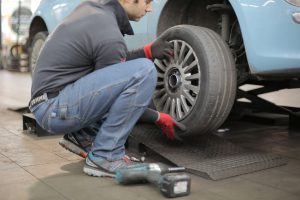How to Identify Run-flat Tires
In the event of a catastrophic blowout, run-flat tires are engineered to stay on the rim. These tires have a gel layer under the tread surface and are self-sealing. If it breaks, the gel will immediately build a seal around the hole in the debris. They are usually irreversible. The majority of newer vehicles come standard with run-flat tires. 
After they’ve been cut or punctured, run-flat tires can be driven “flat” to some extent at a slower speed. You’ll have enough time to get to a mechanic. However, the distance and speed that run-flat tires can travel after being punctured are determined by the tire brand and the vehicle’s current weight.
Inspect the tires for certain codes and marks to identify run-flat tires:
Examine your tires
With the use of a flashlight, examine the tire’s sidewall. By inspecting the features of your tire, you can usually tell if it is run-flat.
Look for words like “run-flat,” as well as markings and codes
Some tires are clearly labeled as “run-flat” on the side of the tire for easy identification. Look for codes like ZP, RFT or ROF (Run-Flat Tire/Run On Flat), SEAL, or marks like a flat tire with an arrow pointing away from it. If necessary, use a magnifying glass to see the symbols. Inspect the rim section of the tire because many run-flat tires feature plastic load-bearing slugs instead of standard rubber rims linked to the wall.
Here are some brands and their codes:
Bridgestone – RFT/ROF/RSC (Run Flat Tires/Run On Flat/Run-Flat System Component)
Continental – SSR (Self-Supporting Run Flat)
Dunlop – DSST (Dunlop Self-Supporting Tire) or DORT (Dunlop Off-Road Tire)
Goodyear – ROF or EMT (Run On Flat/Extended Mobility Technology)
Pirelli–RSC (Run Flat System Component)
Yokohama – ZP (Zero Pressure)
Michelin – ZP or ZPS (Zero Pressure or Zero Pressure System)
Other brands – ZP or ZPS (Zero Pressure or Zero Pressure System)
Here’s another way to tell if your tires are flat:
- Consult your car’s owner’s manual. If your tires are run-flat, the manual will explain why. It comes with a Tire Pressure Monitoring System.
- Your vehicle is more likely to have a run-flat tire if it is newer. To find out, look at your car’s tire. On several of their vehicles, BMW is the most prevalent brand to employ run-flat tires. Lexus and Toyota are two companies that do the same thing.
- Check to see if your vehicle has a spare tire. If your car has a spare tire, it is almost certainly not a run-flat tire, as run-flat tires do not come with one in the trunk. If your car comes with a tire repair kit instead of a spare tire, it can be run-flat.
- Look for a tire pressure warning light on the driver’s side of the dashboard. The air pressure in tires is monitored by a Tire Pressure Monitoring System in cars with run-flat tires.
If you’re still not sure, ask your car dealer if the vehicle has run-flat tires.
